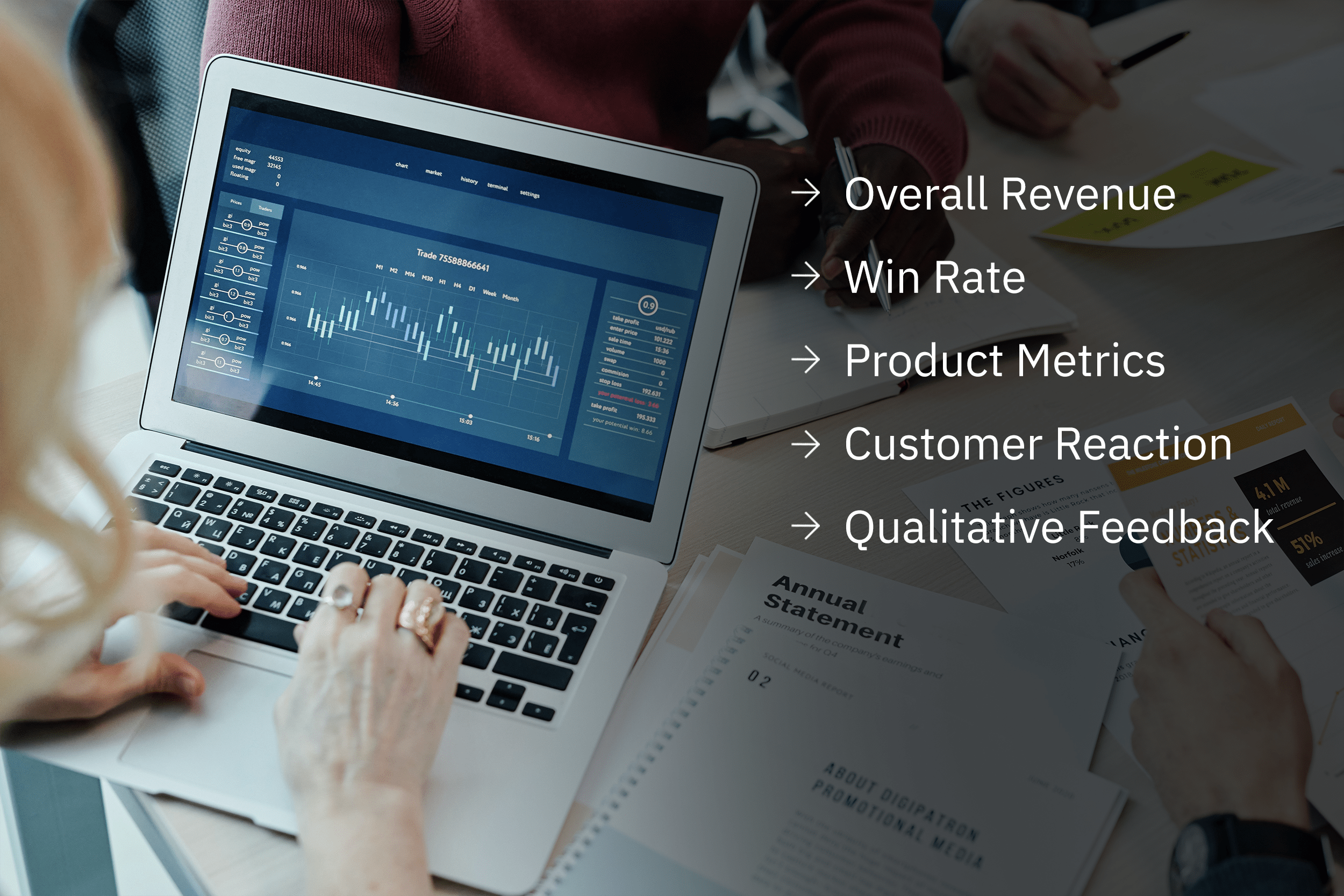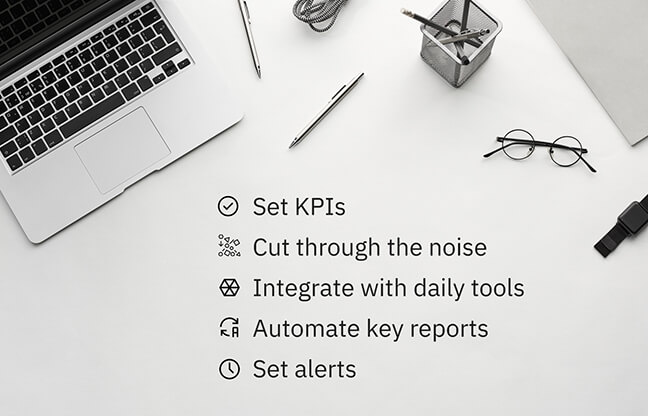Introduction
T he global business world is intensely competitive. Having a competitive advantage over other players in your business is not only a sound business strategy but a necessity. This can be achieved by thorough research into your competitor profile, their marketing strategy, social networks, job postings, etc. Gathering this information, known as Competitive Intelligence (CI) gives you a lot of ammunition to use against your competitors, but is all for naught if you're unable to analyze and decode it to your advantage.
This process thus, called competitive intelligence analysis, is more important than data collection itself. According to Harvard Business Review, the goal for strategic intelligence is not to collect market information, but to use that information to generate insights that in turn support ever-changing perspectives. It involves creating reports, comparing metrics, and utilizing tools at your disposal. This actionable guide is a compendium that will provide you with all you need to know about this process, helping you get the best of your competitive intelligence programs. Let's begin!
What Is Competitive Intelligence Analysis?

Competitive Intelligence Analysis (CIA) can be defined as the aggregation or analysis of competitive intelligence in a way that furnishes you with a comprehensive understanding of a competitor’s products, services, value proposition, capabilities, and weaknesses.
CIA is similar to competitor analysis, but a much broader term that includes extensive information on more topics concerning the market landscape than just your competitor. The information gleaned through such an analysis should be highly specific and timely, allowing for quick decision-making. It should be collated in the form of a report, having all the relevant metrics and created using robust tools to give you an accurate head-to-head with your competitors.
You could also use a competitive and market intelligence platform like Contify for your market intelligence requirements. However, CIA should never be used to duplicate a competitor's strategy, as without access to proprietary information, what works for them might not work for you.
Take a 7-day free trial of Contify’s Market and Competitive Intelligence Platform >>
Steps to Prepare Competitive Intelligence Analysis Report

Gathering competitive intelligence is half the battle. Analyzing it and collating it in the form of a report is how you ensure its proper distribution within your company in the most efficient and organized manner. The steps involved are pretty simple.
Deciding Who The Report Targets
Any company will have several competitors they track using CI. Thus, your report must include both direct competitors who are very active in your target market, new competitors emerging in the industry, as well as top companies in a similar industry or with the same business model. Including the right mix of competitors in your report will ensure that you get a well-rounded blend of strategies, tactics, and best practices to apply in your space.
Deciding What To Include In The Report
“What do you hope to gain from this report?”, is the first question you should seek to answer. Compile the report based on areas you wish to explore or questions you want to be answered. The ultimate goal is to compare yourself against the competition, so you can leverage best practices and enhance your current performance. Typically, the report should contain insights and intel on your competition, in addition to:
1. Details on your business’s target market: For example, demographics, psychographics, and needs of your potential customers to understand the audience you and your competitors are targeting.
2. Features of your product compared to your competitors’ products: Plus, the unique selling propositions (USPs) in comparison to what competitors offer, identifying gaps and overlaps.
3. Positioning of the competitor's product: How competitors market their products, including the messaging and value propositions they use to appeal to their target audience.
4. Current and projected market share, sales, and revenues: Quantitative data on your and your competitors’ market presence and forecast future trends to gauge market dynamics.
5. Comparisons of pricing models: Your pricing structure with those of your competitors, any competitive pricing strategies like discounting, premium pricing, or subscriptions.
6. Analysis of marketing strategy and social media strategy: Channels, content, and campaigns your competitors use for marketing, including their presence and engagement on social media platforms.
7. Details of customer ratings of the product/service features of each competitor: Customer feedback and ratings from review sites, social media, and other forums to assess strengths and weaknesses in the eyes of consumers.
Putting Together Your Report
Ensure that report has easy readability and is digestible. Plot all your metrics and intel on a grid, like on a spreadsheet for efficient organization of data. Create additional tabs for each of the top three to five competitors that will cover different metrics mentioned before. You could also create tabs for metrics and list insights/intel from different competitors there. How you organize the view of the report is up to you.
For example, you could use a competitive matrix. A competitive matrix is a graphical representation of how your competitors perform on various criteria, such as product features, pricing, market share, customer satisfaction, etc. It can help you identify your competitive advantage, gaps in the market, and areas for improvement.
Viewing the Competitive Intelligence Analytics in a report form allows you to identify trends, factors, and patterns. Prioritize the action items and tests gleaned from this report for your company's success.
Important Metrics to Consider for Competitive Intelligence Analytics

Companies usually have predefined quantitative and qualitative metrics on the basis of which they benchmark their organization against their competitors. These metrics are a part of competitive intelligence analytics. Although these metrics may be slightly different for each organization, and most likely set as per the requests of the executive/leadership team of the organization, they usually include the following key metrics:
1. Overall Revenue
Overall revenue is always a part of the key metrics of every organization and includes the breakdown of their planning, efforts, and strategies.
2. Win Rate
The win rate of any company, also known as the win/loss ratio, is calculated by dividing the number of won sales deals by the number of lost sales deals. It reflects the efforts of the sales and marketing teams, and can also help uncover strengths and opportunities.
3. Product Metrics
Of course, without a product or service, there is no company. Product metrics focus on driving awareness, demand, sales, and usage of a product or feature whether new or old. They include, but are not limited to:
- Trials started and/or demos requested
- Content views, including product page views and video views
- Press coverage for the announcement of a new product
- New customer or feature(s) upgrade revenue
- Product usage and/or adoption of a new feature
Product metrics, both your own or that of your competitors, can help build new campaigns, features, and strategies or end old ones.
4. Customer Happiness/Retention
Customer happiness or retention is another one of the highly important factors that affect business. Customer happiness is usually sourced from product reviews, customer surveys, and net promoter score (NPS), while customer retention is calculated using this formula: Number of customers at end of the period - Number of customers acquired during the period / Number of customers at the start of the period.
5. Qualitative Feedback: Internal and External
Statistics sometimes lie, or rather not always reliable, which is why qualitative feedback is always a part of every analysis. Both internal and external qualitative feedback is important, as it'll help you fully leverage your CI insights.
Beginning with internal feedback, what your primary consumer or stakeholder has to say about your CI analysis is crucial. After all, they are the ones who are going to utilize this information. Internal surveys must focus on the usage of CI content, the HOW, WHEN, and WHY it is being used, IF it is being used, as well as WHAT is useful and what isn't. This will help you make changes for the better in your future reports.
External feedback helps a company understand how they're viewed externally, which is a key concern among every organization. External surveys should be provided to prospects (companies or individuals) to gain awareness of how they see each company (yours and your competitors') in the market; this will help you understand whether the differentiation efforts are working or not.
Role of CI Tools in Competitive Intelligence Analysis

Gathering and analyzing competitive intelligence requires a lot of effort and research from a company's various teams, including sales & marketing teams, business strategy teams, product teams as well as executive/leadership teams. There's usually a dedicated CI team as well. Competitive intelligence tools can help reduce these efforts and augment them, which is why they're desirable. There are a number of CI tools like Contify available on the market, which help optimize your time and maximize productivity in the following ways:
- 1. Set KPIs
- CI tools that leverage artificial intelligence and/or machine learning (like Contify) allow you to set KPIs (key performance indicators), which in turn help you glean relevant and critical insights. You can use custom filters and group competitors to fine-tune your results.
- 2. Cut through the noise
- Filtering irrelevant data from intelligence manually can take up a lot of bandwidth. CI tools can help refine your data sources so that you only track the data points that matter most to you and your organization.
- 3. Integrate with daily tools
- CI tools can integrate with other tools you and your teams use daily, such as Google Drive and your CRM, and provide multi-channel publishing. This helps simplify collaboration and distribution to stakeholders.
- 4. Organize insights and information
- Unless and until your intelligence is distributed in an organized and readable format, your stakeholders will have problems making the most of it. CI tools can help you with things like creating taxonomies, filtering your insight feeds, saving your go-to filters, printing insights in a report format, and much more, to make it digestible.
- 5. Automate key reports
- CI tools can help you automate the generation of key reports, which will help reduce manual effort and time. Reports and dashboards will be generated using your preset preferences.
- 6. Set alerts
- There are certain competitors and/or topics you're especially interested in. Using CI tools, you can save time and maximize the visibility of such updates by enabling and customizing alerts specific to your use cases.
The role of CI tools, thus, is to make things not only easier, but much more efficient for you, your teams, and your organization.
FAQs
What is the Purpose of Competitive Intelligence Analysis?
The purpose of competitive intelligence analysis is pretty straightforward. It helps companies understand their market landscape, market share, competitors, competitive environment as well as the opportunities and challenges they'll face in the industry. Such an analysis is imperative to discover strategic areas and create effective and efficient business practices, which help you position yourself for a win using a Go-to-market strategy (GTM). Here are some key objectives of conducting a competitive intelligence (CI) analysis:
1. Understanding Market Conditions - Markets are getting exceedingly dynamic. You're not just competing with businesses that offer products and/or services similar to yours, but indirect competitors who might be thinking about expanding into your industry. An intelligence program allows you to gain a comprehensive understanding of the market, preparing you for anything that might come.
2. SWOT Analysis - To compete with and outdo your rivals, whether direct or indirect, you need to size yourself up against them. Not only that, you need to do your research on who your ideal customers are, to better position your products and/or services. Self-awareness is often understated, but it is the guiding star of planning. A SWOT analysis will help you invest in good opportunities and reject bad ones, and build effective strategies around your strengths.
3. Designing Your GTM Strategy - A CI analysis will reveal several insights about your ideal customer, market and competition, product offering and pricing, and channels necessary to reach your customers. It is up to you to utilize these insights to weave through the market dynamics and determine how your organization and your product or service fit in the marketplace. The analysis will help you design and improve your GTM strategy.
How Does Competitive Intelligence Analysis Improve Business Performance?
There are numerous ways competitive intelligence analysis helps companies improve their business performance. Let's have a look at a few of these.
1. Insights and information gleaned through such an analysis help deduce the pattern of the market. This helps forecast future market conditions, aids in planning and enhances future business decisions.
2. One of the long-term benefits of a competitive intelligence program is complete knowledge of the external business environment or landscape, which lets companies plan efficiently and flawlessly, increasing their longevity in business.
3. Regular and timely insights extracted from a CI analysis against your competitor can help predict their action plans, identify their weaknesses and offer you opportunities to outsmart them. It also helps in differentiation from your rivals.
4.Competitive intelligence, when distributed efficiently, enhances the market knowledge of the entire organization and improves overall business performance. Thus, the company must ensure that relevant information gleaned from the CI analysis is personalized and dispensed to the key stakeholders in the organization, as per their needs.
5. Continuous use and development of a competitive intelligence program helps in planning counterintelligence. When you know how competitive intelligence can be used against others, you'll know how to save yourselves from being its victim.
Download M&CI Process Template
How Do You Gain Competitive Advantage?
You gain a Competitive Advantage by knowing. Knowing your competition, their website, their brands, the industry, and the marketplace. Gaining a competitive advantage also involves knowing and employing advanced competitive intelligence tactics, a lot of developments and growth, as well as the improvement of various departments.
The marketing team will have to step up their marketing efforts and market research, sales teams will require sales enablement and improve account planning, leadership will have to make better and informed decisions, strategy teams will have to strategize keeping the present and future in mind, and the product team will have to be empowered with competitors' product insights.
This can all be achieved using competitive intelligence. Your company needs to have a compelling value proposition to stand out. This is how you prove to prospective buyers that your solution is the right one, and when your entire team is fuelled by actionable insights, you'll surely gain a competitive advantage. CI will give you the competitive edge you require.
Conclusion
The more knowledge and information you have about the external market and your competitors, the better your decisions are likely to be. As your competitive intelligence strategy will grow and mature, you'll learn more about the process, and as you gain confidence in your ability to use the information wisely, you will see growth in your business. Effective decision-making is the key to organizational success, and competitive intelligence provides many valuable inputs to that process. You'll improve your business performance by using these inputs strategically and intelligently. Hope this article helps you understand the competitive intelligence analysis process and helps you make the most of it!











